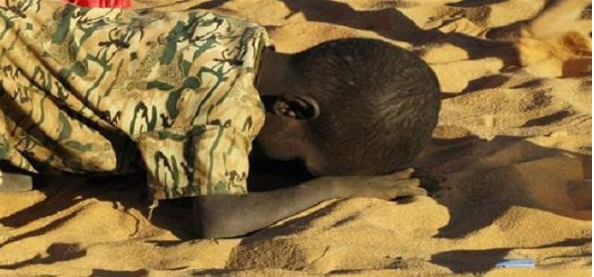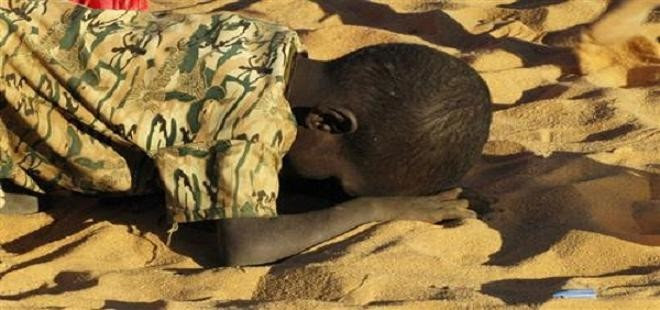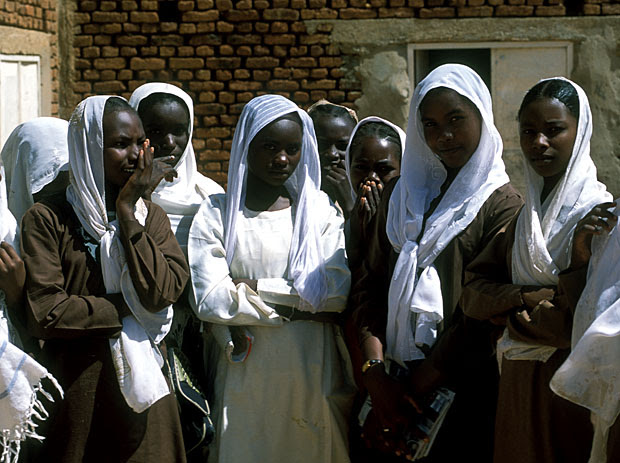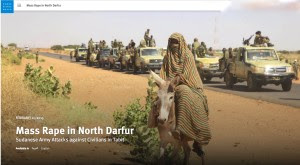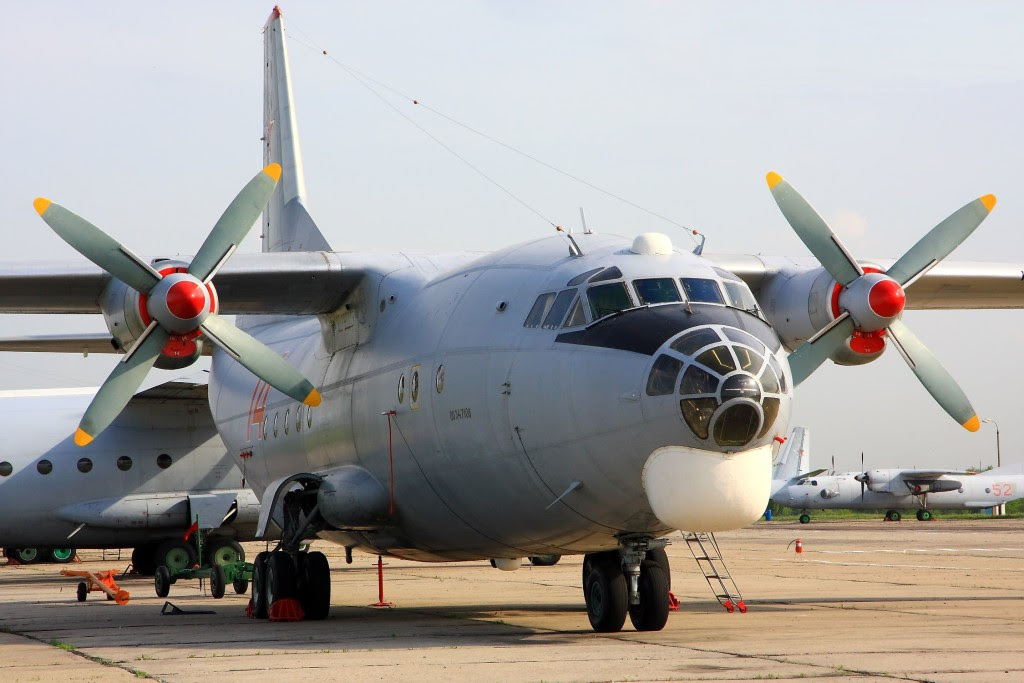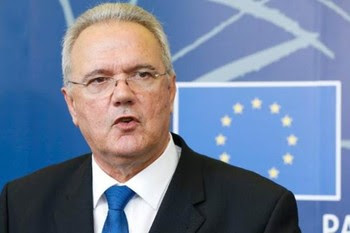Genocide Watch exists to predict, prevent, stop, and punish genocide and other forms of mass murder. Our purpose is to build an international movement to prevent and stop genocide.
Staff Login
Despairing 14-year old Boy Commits Suicide in Darfur Camp: Suffering from which international eyes remain averted
Despairing 14-year old Boy Commits Suicide in Darfur Camp: Suffering from which international eyes remain averted
Eric Reeves | July 28, 2016 | http://wp.me/s45rOG-7384
The dispatch from Radio Dabanga was terse, compact—and to my moral sensibility outrageous:
A 14-year-old has committed suicide in a camp for displaced people in Zalingei, Central Darfur. The coordinator of Hamidiya camp, El Shafi Abdallah, reported the suicide on Wednesday to Radio Dabanga. The boy hanged himself with a rope in his family’s home. Abdallah said that the living conditions of the boy’s family were bad because of poverty. “The majority of the population in the camps faces the same worsening humanitarian conditions.”
(Radio Dabanga file photo accompanying July 22, 2016 dispatch)
It should be worth the world’s effort to reflect on the appalling conditions in Darfur, and of course in Blue Nile, South Kordofan, and much of eastern Sudan. But thirteen years of genocidal counter-insurgency efforts by Khartoum have taken a devastating toll, and continue to do so.
The view of the Obama administration is that with Khartoum’s savage offensive against the rebels and civilians in Jebel, the military success by the regime is largely complete and it is time to accommodate U.S. Sudan policy to this fait accompli. Militarily, the view may be correct, although recent victories by the Sudan Liberation Army/Abdel Wahid would seem to suggest that significant fighting between military forces continues.
But the violence that takes form as military assaults and militia predations on civilian populations, in the camps for displaced persons and in rural areas, continues unabated—throughout Darfur. Humanitarian conditions continue to deteriorate as humanitarian capacity and access diminish even further.
During his current trip to North Darfur, Obama administration Special Envoy for the Sudans, Donald Booth, is nominally conducting what is billed as an assessment mission in North Darfur. It is, of course, nothing of the sort. Although North Darfur and parts of Central Darfur have been the hardest hit by genocidal violence over the past four years, Booth will see only what Khartoum wants him to see. He is completely at the mercy of decisions made by Military Intelligence, long the Khartoum regime’s primary security instrument in Darfur.
Donald Booth, President Obama’s third Special Envoy for the Sudans
PRESENT CONDITIONS IN DARFUR
Khartoum continues to ban all journalists and human rights reporters from Darfur, and there is no evidence in the way of dispatches indicating that journalists are accompanying Booth. The UN/African Union Mission in Darfur (UNAMID)—even with a renewed mandate (June 30, 2016)—continues to prove hopelessly inadequate, both as a protection and a reporting force. We must perforce rely on Radio Dabanga (and to a lesser extent Sudan Tribune). To be sure, Khartoum has already begun to have a field day with Booth’s visit (Sudan Vision, a primary regime propaganda organ, today (July 28, 2016) declared that “US Envoy to Sudan Hails Government Efforts for Realizing Peace and Stability”).
Khartoum has also had some success in limiting the reach of Radio Dabanga; but this critical news source continues its daily reporting, in English and Arabic, both by broadcasts and web postings. These give us, without question, our fullest and most detailed account the immense human suffering that proceeds from the violence that is being kept from the sight of Special Envoy Booth.
For its part, the U.S. State Department recently declared of a meaningless rainy-season ceasefire declaration by Khartoum:
We find this [cease-fire declaration] an important and welcome step towards a peaceful resolution to conflict in those states, which we would like to see extended to the Darfur region. An end to military offensives and fighting in these areas would bring much needed relief to thousands of Sudanese and create an improved environment for dialogue leading to a political solution.
“Thousands”? What a preposterous, finally mendacious statement. The figure for Sudan, including Darfur, Blue Nile, and South Kordofan is in the millions. The UN Office for the Coordination of Humanitarian Affairs (OCHA) provides a useful counter-balance to this absurdity, declaring in its most recent Weekly Bulletin (July 24, 2016):
The humanitarian situation in Sudan continues to deteriorate. Despite years of assistance, humanitarian needs remain acute and in some cases are worsening. These humanitarian needs are predominantly caused by armed conflict which, in turn, drives displacement and food insecurity.
OCHA provides two figures should have particular significance in understanding the scale of humanitarian needs:
Displaced people in Darfur (as of December 2015) – Up to 2.6 million
[This figure does not include the more than 150,000 people displaced during this year’s Jebel Marra offensive by Khartoum’s regular and militia forces—a figure that now very likely exceeds 200,000, which would bring the total number of those internally displaced in Darfur to 2.8 million. Including the 300,000 Darfuri refugees who remain trapped in eastern Chad, there are more than 3 million people who have been driven from their homes. This is almost half the pre-war population of Darfur—even as those displaced belong overwhelmingly to the non-Arab or African tribal populations—ER]
Global Acute Malnutrition caseload for Sudan—2.1 million (UN OCHA)
As grim as it is, this figure seems to understate the scale of the problem of malnutrition in Darfur and Sudan as a whole. The unreleased UNICEF study of 2014, leaked Nicholas Kristof of the New York Times contains data that should cause alarms of a much greater nature than we presently here:
Acute malnutrition rates for children in Sudan among the highest in the world:
North Darfur: 28 percent acute malnutrition among children
South Darfur: 18 percent acute malnutrition among children
East Darfur: 15 percent acute malnutrition among children
South Darfur: 13 percent acute malnutrition among children
West Darfur: 8 percent acute malnutrition among children
Other notable acute malnutrition rates among children:
Red Sea State: 20 percent
Blue Nile: 19 percent
Kassala: 15 percent
South Kordofan: 10 percent
(Source: S3m Survey, 2013)
[This date suggests that much of the malnutrition that has developed since the violence began in South Kordofan and Blue Nile (summer 2011) is not reflected in these numbers—ER]
Chronic malnutrition among children is widespread and pervasive:
[A second graph reports the following figures for chronic malnutrition among children in Sudan—ER]:
Central Darfur: 45 percent
East Darfur: 40 percent
West Darfur: 35 percent
North Darfur: 35 percent
South Darfur: 26 percent
[The report indicates that the World Health Organization cutoff point for “high” prevalence of chronic malnutrition is 30 percent, and for “very high” prevalence > = 40 percent—ER]:
(Source: S3m Survey, 2013)
[See also Save the Children’s Acute Malnutrition Summary Sheet—ER]
[A third chart indicates—ER]:
“Percentage of under-fives [children] moderately or severely wasted in the 10 most affected countries” (Sudan ranked 4th from the bottom in this category in 2010—ER]:
Wasting prevalence for country population under five:
Moderate or severe wasting: 16 percent
Severe wasting: 5 percent
[A great many children so severely malnourished will die; we will see many more dispatches like the following:
• Children die of malnutrition in Lobe, South Darfur | July 24, 2016 | DERIBAT
Despite the importance of these data, UNICEF has still not released them for fear of offending Khartoum.
Instead, in what amounts to a grotesque misrepresentation of the larger realities of children facing acute danger throughout Darfur, UNICEF released this month a dispatch about the very large Zamzam IDP camp near el-Fasher, capital of North Darfur (“In North Darfur, Child Friendly Spaces bring happiness and stability in the shadow of conflict,” July 5, 2016). There can be no independent verification of how widely utilized this initiative is; but Zamzam, was prior to this year, a camp of more than 200,000 people, and that number has grown considerably this year as a result of Khartoum’s Jebel Marra offensive. Dispatches from Radio Dabanga suggest that children in Zamzam camp are likely to be without adequate food, water, or medical care, including psychosocial treatment (to which Khartoum is particularly averse):
• Thirst in North Darfur’s Zamzam camp | June 21, 2016 | EL FASHER
Displaced people in Zamzam camp in North Darfur say there is not enough drinking water for the entire camp’s population. Some residents are unable to pay the high water prices that resulted from the shortage. A source in Zamzam camp, near El Fasher, reported to Radio Dabanga that less than 30 out of 79 pumps are operative. “They are broken down and there is the problem of a scarcity of surface water. Local authorities should speed up finding a solution by digging wells.”
Water shortages and long lines for what water there is are chronic in Darfur–reflecting decades of neglect by the Khartoum regime
• Starvation as less than half receive rations in North Darfur camp | June 5, 2016 | EL FASHER
Only about 100,000 of the 237,000 displaced in Zamzam camp, south of El Fasher, capital of North Darfur, have been receiving rations. They describe the humanitarian and security situation as dire. An activist told Radio Dabanga that there have been deaths among children and the elderly from malnutrition and hunger.
“The humanitarian situation in the camp is catastrophic and tragic. There is also a severe shortage of other services such as school supplies, water wells, plastic sheets and shelter tents.”
• Health situation in North Darfur’s Zamzam camp deteriorating | August 24, 2015 | ZAMZAM CAMP
• Sudanese medics denied access to North Darfur camp | May 17, 2016 | EL FASHER
A medical team representing several organisations was prevented from practicing their daily work in Zamzam camp for displaced people, near El Fasher city, on Monday. Members of the security apparatus prevented the team of Sudanese medics from entering the camp and treating the displaced people.
• Displaced in North Darfur camp “beg for food” | May 29, 2015 | EL FASHER
What UNICEF should be highlighting is not one small provision of assistance to children in Zamzam, but the continual rape of girls by militiamen serving as proxies for Khartoum, and the total lack of safety in most camps for the displaced. Nothing could be more traumatic for girls than sexual assault, including gang rape, and yet they are vulnerable everywhere, including on the outskirts of Zamzam camp:
• Nine raped, including minors, near North Darfur camp | March 1, 2016 | EL FASHER
Gunmen raped nine displaced women from Zamzam camp in North Darfur on Saturday 27 February. Among them were four minors. The camp coordinator in El Fasher locality told Radio Dabanga that a group of gunmen riding camels attacked the displaced girls and women when they were out collecting hay northwest of Zamzam. The attackers took the group to an adjacent valley at gunpoint,, where they raped the five women and the girls, aged 11, 12, 14, and 15 years. “They were at their hands for a full day and systematically raped,” the coordinator said. “They were not released until the next day.”
Girls from the African tribal populations are the prime targets of for Khartoum’s militiamen and regular armed forces. Sexual assault continues on a daily basis as a weapon of war.
UNICEF should be highlighting the terror created among large populations of children by the continual rain of bombs from Khartoum’s military aircraft—and the dangers created by the massive amount of Unexploded Ordnance (UXO) (see below).
The desperately grim realities of Darfur are there for those who choose not to avert their eyes from what remains one of the very worst ongoing human catastrophes worldwide. Scandalously, those who know most about these realities are censoring themselves because of Khartoum’s relentless war of attrition against humanitarian organizations and UN agencies.
MENTAL HEALTH: The first line item to be cut as humanitarian capacity contracts
The suicide of the boy in Hamidiya camp near Zalingei is at once shocking and yet part of a pattern that has been medically in evidence for years. There have long been gross deficiencies in primary health care in all three Darfur states; the number of physicians serving enormous populations is often one or two. Psychosocial services for the vast numbers of displaced are virtually non-existent, even as studies (when they were permitted) have suggested extraordinarily high levels of depression and Post-Traumatic Stress Disorder (PTSD), especially among children. In August 2011 the distinguished British medical journal The Lancet published findings of a shocking magnitude:
Investigators of studies with medium to large sample sizes have concluded that forcibly displaced children in low-income and middle-income settings have high rates of psychiatric disorders. Thus 75% of 331 displaced children in camps for internally displaced people in southern Darfur met diagnostic criteria for post-traumatic stress disorder, and 38% had depression. [The precise date of data acquisition from South Darfur is not clear in the synopsis that appears on-line at present—ER]
Finally, we know why the boy in Hamidiya camp committed suicide; we know that children have been traumatized to an almost unimaginable degree. And yet since the 2011 study by The Lancet, psychosocial services for children have declined dramatically, even as the trauma of violence that produces these staggering figures continue unabated.
The immense psychosocial consequences of rape for girls and women should bee seen in the same context. Our best document to date is a devastating study by Physicians for Human Rights. In “Nowhere to Turn: Failure to Protect, Support and Assure Justice for Darfuri Women” (May 2009 (http://
Researchers asked women to rate their physical and mental health status in Darfur and now in Chad on a 1-5 scale with 1 being “very good” and 5 being “poor….” The study indicated a marked deterioration in self-reported mental health, where the average score in was 4.90. “I am sad every day (since leaving Darfur). I feel not well in my skin,” explained one respondent. [ ] Women who experienced rape (confirmed or highly probable) were three times more likely to report suicidal thoughts than were women who did not report sexual violence.”
A sense of the scale of the sexual violence in Darfur is most readily apparent in an April 2012 study released in PLoS Medicine and based on the work of a number of authors, most prominently Dr. Mohamed Ahmed Eisa, whose archives from the Nyala-based Amel Center for Treatment & Rehabilitation for Torture Victims were essential in generating that data the permitted publication in this peer-reviewed medical journal:
Approximately one-half (49%) of all women disclosed that they had been sexually assaulted, and one-half of sexual assaults were described as having occurred in close proximity to a camp for internally displaced persons (“Medical Evidence of Human Rights Violations against Non-Arabic-Speaking Civilians in Darfur: A Cross-Sectional Study,” PLOS Medicine, April 3, 2012 | DOI:10.1371/journal.pmed.
In January of this year, I attempted to quantify data on rape on the basis of reports over the past two years from Radio Dabanga and other sources the scale of rape, particularly the rape of girls: Continuing Mass Rape of Girls in Darfur: The most heinous crime generates no international outrage | January 2016| http://wp.me/p45rOG-1QG
Human Rights Watch reported authoritatively on the mass rape of more than 200 women and girls in Tabit, North Darfur in late 2014 by regular army forces (the Sudan Armed Forces or SAF) (see here)
And rape continues to be reported on a terrifyingly regular basis by Radio Dabanga (here from the past month alone, and only what is reported to RD):
• North Darfur woman raped by four militiamen | July 24, 2016 | SHANGIL TOBAYA
• Five women and girls assaulted, raped in North Darfur | July 27, 2016 | SORTONY / NYALA
• Displaced farmer raped in West Darfur | July 21, 2016 | MURNEI
• Gunmen murder one, rape two in Darfur | July 26, 2016| GIREIDA / TABIT
• Two girls raped, farmer abducted in East Jebel Marra | July 1, 2016 | EAST JEBEL MARRA
• Six gang-raped in North Darfur, East Jebel Marra | June 28, 2016 | TAWILA / TABIT / EAST JEBEL MARRA
On Monday, six young women were gang-raped in separate incidents in North Darfur and East Jebel Marra. Omda Mukhtar Bosh, coordinator of the Tawila camps for the displaced, told Radio Dabanga that a group of militiamen on camels ambushed eight residents of the Argo camp on Monday.
• West Darfur village raided, two women raped | July 8, 2016 | FORO BARANGA
• Girl raped in Darfur’s East Jebel Marra | July 6, 2016 | FANGA
NO PROVISION OF PRIMARY HEALTH CARE
Primary health care deficits in Darfur long antedate the current genocidal counter-insurgency. Indeed, acute marginalization—including lack of hospitals, clinics and medical staff—defined Darfur for decades prior to the outbreak of major violence in 2003. Medically, however, conditions have deteriorated badly as the humanitarian needs of displaced persons have far outstripped relief resources—and the gap between need and humanitarian capacity only grows
• ‘No health care in South Sudan Duro camp’: Darfur refugee | July 7, 2016 | DURO REFUGEE CAMP
• Malnutrition rife in Central Darfur camps | July 20, 2016 | ZALINGEI
2016 is proving to the “the worst year since 2010” for malnutrition and disease in the five camps for the displaced at Zalingei in Central Darfur. The coordinator of the camps of Central Darfur state, El Shafie Abdullah, told Radio Dabanga that this year’s death toll due to malnutrition among children and pregnant women has mounted to about 100 cases. He attributed the causes of death to lack of health care in the camps, along with the lack of humanitarian aid provided by the organisations.
• Darfur displaced living rough | July 10, 2016 | DARFUR
• No services yet for East Darfur returnees | July 4, 2016 | YASSIN
VIOLENCE AFFECTING CIVILIANS
As bad as conditions are in the camps for displaced persons, as dangerous as they have become, they are still the only place of refuge for millions of people who have fled violence or the threat of violence. And there has been no let up, whatever Khartoum’s propaganda ministers or an acquiescent African Union might try to suggest:
• Four injured in Central Darfur camp fight | July 10, 2016 | MUKJAR
• Civilians again targeted across Darfur | June 30, 2016 | JEBEL
• Darfur farmers robbed of engines, money | July 25, 2016 | KUTUM / NIERTETI
• Tension rises as paramilitaries enter Central Darfur town | July 12, 2016 | NIERTETI
• Barrel bomb kills three in Darfur’s East Jebel Marra | July 10, 2016 | EAST JEBEL MARRA
A Russian-built Antonov-26 cargo plane, used to drop shrapnel-loaded barrels bombs from high altitudes; they have no militarily useful accuracy; they are instruments of civilians terror and destruction
• Two children die in North Darfur UXO blast | July 8, 2016 | MELLIT
• ‘Force out rebels from camp’: North Darfur Governor | July 8, 2016 | SORTONY
Governor Abdelwahid Yousif has threatened to use force to evict what he called “the rest of the members of the Sudan Liberation Movement led by Abdel Wahid El Nur” from Sortony, a site for people who have been displaced from Jebel Marra earlier this year. Yousif called upon the African Union-United Nations Mission in Darfur (UNAMID) to force out the rebels during a meeting with the mission’s deputy chief and the state security committee on Tuesday. He said that they are preventing displaced people from returning to their villages in Jebel Marra by force of arms.
The coordinator of the Kabkabiya camps told Radio Dabanga that no armed rebels are present in Sortony. “All those inside the camp are the victims of aerial bombardments and attacks by Sudanese military forces and militias on villages in Jebel Marra.”
• Two die in North Darfur UXO explosion | July 10, 2016 | FANGA
• Three dead as militiamen shoot at South Darfur farmers | July 18, 2016 | GIREIDA
A large group of militiamen shot three displaced farmers dead and wounded six others in Gireida locality in South Darfur on Sunday. Speaking to Radio Dabanga, a farmer reported that about 50 militiamen, some of them in a Land Cruiser, and the others riding camels and horses, arrived at the farmlands near Askalaya village, about 10 kilometres west of Gireida town, on Sunday afternoon.
• Armed robberies leave three dead in Central Darfur | July 14, 2016 | MUKJAR / DELEIG / TABIT
• Crimes in Darfur: Four killed, Sheikh abducted | July 13, 2016 | ROKORO / GIREIDA / NIERTETI
• Farmers attacked in Kutum, North Darfur | July 11, 2016 | KUTUM
On Saturday, a group of militiamen shot three farmers in Kutum locality. “Janjaweed riding a Land Cruiser attacked us late on Saturday evening after we had driven a number of their camels from our farmlands,” one of the victims reported to Radio Dabanga.
• Paramilitaries shoot woman, daughter in Central Darfur | July 11, 2016 | NIERTETI
A woman and her daughter were wounded in an attack in Nierteti, Central Darfur, on Sunday. A relative of the victims reported to Radio Dabanga that “three uniformed paramilitaries tried to steal a donkey from Fatima Mohamed Daoud in front of her house in the outskirts of Nierteti on Sunday morning. “When she resisted, they shot Fatima in her leg. Her daughter Hanouna (10) was hit in the back on the back. The attackers took the donkey and fled.”
• Eight wounded in North Darfur robberies | July 11, 2016 | KABKABIYA
• Militia attack leaves three South Darfur farmers in hospital | June 27, 2016 | GIREIDA
Three farmers were injured when a group of paramilitaries opened fire in Dugma, seven kilometres northeast of Gireida in South Darfur. Witnesses from Gireida told Radio Dabanga that Adam Abdullah Ali, Mohammed Abdullah Ali, and Ahmed Mousa Daoud were tending their farms on Sunday morning. They were attacked by ten paramilitary group members riding camels. [There has been a sharp uptick in reports of violence in South Darfur over the past year—ER]
• Tribal fighting in West Kordofan and Central Darfur | July 13, 2016 | LAGAWA / UM DUKHUN
• Family members slain in Central Darfur | July 5, 2016 | DELEIG / EL GENEINA
Khartoum has as a primary goal forcing the UN/African Union Mission in Darfur (UNAMID) into a premature exit. While UNAMID has failed badly, it is all that allows international nongovernmental humanitarian organizations to maintain their presence in Darfur (and that is with staff that is approximately 97 percent Sudanese nationals). Khartoum has a long history or orchestrating violence against UNAMID (see url), but recently there has been an even more confrontational attitude, clearly at the behest of military and political elements in Khartoum (distinguishing the two has become increasingly difficult over the past five years):
• Attacks on civilians, peacekeepers increasing: UN
June 11, 2015 UNITED NATIONS (REUTERS) – The United Nations on Wednesday warned that violent attacks on international peacekeepers and civilians in Sudan’s conflict-torn Darfur region have been increasing while tens of thousands of people have been forced to flee the fighting. UN officials and diplomats say the Sudanese government has become increasingly confrontational toward the United Nations and the West over the joint UN-African Union mission to Darfur (UNAMID), which Khartoum wants shut. Deputy UN peacekeeping chief Edmond Mulet told the 15-member Security Council that there has been negligible progress in peace efforts for Darfur, adding there was a worrying rise in attacks on UNAMID.
THE INTERNATIONAL RESPONSE: Driven by hasty and in many case supremely ill-considered measures to assist the Khartoum regime stem the flow of refugees to Europe
The Obama administration has at least kept Darfur on its radar screen, if mainly for observational purposes. Still, there are signs of a softening of policy attitudes towards Khartoum as the U.S. lust for counter-terrorism intelligence becomes ever greater. It was this lust that produced the “de-coupling” of Darfur from the central bilateral issues between Khartoum and Washington.
But the Europeans seem utterly shameless in capitulating before the Khartoum regime’s ongoing wars against its own people—willing to make any deal with the devil in Khartoum in order to produce even the slightest reduction in refugee traffic from Africa to Europe.
It falls again to Radio Dabanga (based in The Netherlands) to provide a clear picture of how cynical European thinking has become, citing the EU Observer and a number of other sources. It concludes with what should be obvious to even a traumatized Europe, but clearly is not:
The European Commission and High Representative put forward measures that would assist partner countries in border and migration management activities, including in Sudan, as part of a larger effort to stop people from fleeing to Europe.
On Tuesday, a Joint Communication on security sector reform and a legislative proposal to foster security and sustainable development in partner countries were announced by the European Commission and High Representative Federica Mogherini.
The proposed measures should enhance the European Union’s effectiveness to provide comprehensive assistance to the security sector in partner countries, including the military under exceptional circumstances.
Sudanese army
The Commission’s draft proposal stated that money initially planned for development aid will be diverted to border control management and other proposed measures; without the use of additional financial resources. The Sudanese military may benefit from the EU assistance. Starting last June, Sudan has stationed its paramilitary forces in the western desert near the Sudanese-Libyan border. On Monday the forces claimed the arrest of more than 300 illegal immigrants who were reportedly travelling to Libya to cross the sea to Europe.
Human rights
The paramilitary Rapid Support Forces (RSF) are part of Sudan’s security apparatus, commanded by Brig. General Mohamed Hamdan Dagolo (‘Hemeti’), a former leader of the proxy militias that were popularly known as the Janjaweed in Darfur. According to Human Rights Watch investigations in 2015, RSF members are accountable for widespread systematic crimes against civilians, constituting ‘egregious crimes’ against humanity and war crimes. Most atrocities were part of a widely announced government offensive against armed rebels in Darfur: jointly with the Sudan Air Force, RSF troops repeatedly attacked villages.
The EU’s proposed assistance to partner countries should follow the principles of respect for human rights and adherence to international humanitarian law, the Commission stated on Tuesday. “Development and security go hand in hand,” said Neven Mimica, EU development commissioner following the announcement to finance military activities.
Tackling migration
According to the United Nations Refugee agency (UNHCR), Sudan appears to be one of the main transit countries of Eritreans and Somalis who travel to Italy by sea – two of the largest groups of immigrants arriving in Europe. Recent funding by the European Commission to the Sudanese government, to be implemented under the EU Emergency Trust Fund for Africa, contains the development aid package of €155 million, to tackle the root causes of irregular migration in the country and improve migration management processes.
Sudanese activists have claimed that the EU policies in the campaign against illegal immigration and human trafficking by providing such funds to African governments are futile. They fear that the aid package is used to tighten the grip by the security apparatus on the population.
“‘Development and security go hand in hand,’ said Neven Mimica, EU development commissioner following the announcement to finance military activities.”
Neven Mimica, EU development commissioner
What a contemptibly cynical justification for supporting a regime in Khartoum that wages continual war on its people, spends so profligately that the economy and currency are collapsing, rules as a cruel kleptocracy, and continues to support radical Islam (e.g., Libya Dawn). Supporting Khartoum does nothing to improve “security” for the millions of Sudanese acutely threatened by the actions of a regime that is now scheduled to get substantial financial and material support from the EU (see an extraordinary investigative report from Der Spiegel, May 13, 2016).
This almost certainly represents the lowest, most contemptible point in the European response to Darfur.
—
Eric Reeves, Senior Fellow at Harvard University’s François-Xavier Bagnoud Center for Health and Human Rights
Twitter@SudanReeves
About Eric Reeves: http://sudanreeves.
Philanthropy: goo.gl/Ii4buw

